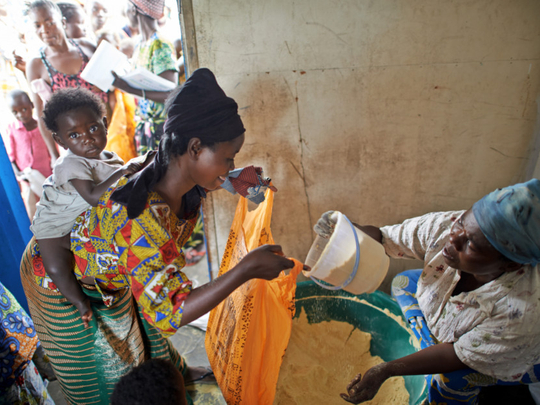
Goma, DRC: The mothers of Kavumu hardly sleep.
But on rainy nights, they don’t even try. The rain pounds on their tin roofs so noisily that they worry they won’t hear rapists breaking in to steal their daughters.
So they sit up all night, just watching their front doors.
Since 2013, 49 young children, one only 18 months old, have been abducted from flimsy houses in this town in the east of the Democratic Republic of the Congo — and raped.
The alleged ringleader of the militia responsible, an MP, was arrested earlier this year, but it is common knowledge in Kavumu that many of their daughters’ “destroyers”, as they call them, are still at large.
“I’m scared. In my area, everyone’s scared,” said Felicia, the mother of a nine-year-old girl, Charlotte, who was raped last year and who sits in silence next to her.
Branded the “rape capital of the world” in 2010 by Margot Wallstrom, the former special representative on sexual violence to the UN, the DRC has been trying to get rid of this moniker ever since.
President Joseph Kabila claimed recently that the DRC was “held up as an example” of how to fight sexual violence, in a rare speech he made to justify staying on as president after his constitutionally mandated two terms officially come to an end this month.
However, despite a sustained PR campaign by the Congolese government to persuade the world that the number of rapes has fallen by 50 per cent in two years, figures obtained by the Guardian show that it has hardly changed, and this has been echoed by people working on the front line of the fight against sexual violence. Some even say it is rising.
Chief of the government’s strategy is Jeanine Mabunda, the special adviser on sexual violence to the president. Kabila appointed Mabunda a month after Angelina Jolie and William Hague’s landmark summit on sexual violence in conflict in London in June 2014, by which point indignation at the Congolese government’s failure to act had reached a crescendo.
Mabunda’s was a high-profile appointment, working across government ministries and with Kabila’s ear, and people who had been trying to stem the rising tide of rape greeted her appointment with hope.
In October, Mabunda flew into Kavumu airport. But she did not stop to talk to the rape survivors. She was with Zainab Bangura, the UN secretary general’s special adviser on sexual violence in conflict, who was paying a last visit to the country after four years in the job.
Mabunda and Bangura hopped into their waiting 4x4s and sped through the town in a large convoy on their way to Bukavu, a nearby city where they had a new police building to inaugurate.
Going the other way
At Bukavu police station, Mabunda gave a speech. “The number of rapes in the DRC has fallen by 50 per cent in two years,” she said. The assembled dignitaries, including the province’s governor, and the head of its UN peacekeeping force, clapped. In recent months, Mabunda has repeated this claim many times: at a high-level conference on rape in conflict in Kinshasa, the capital, at meetings and press conferences across the country, and on her social media accounts.
This is not the case, say the doctors who try to heal the physical scars resulting from rape, the lawyers battling with a largely non-existent justice system, and the Congolese activists trying to rebuild the lives of women who are often abandoned by their families and communities.
“The 50 per cent drop? It’s not true. It’s going the other way,” said one aid worker, who spoke on condition of anonymity.
Reliable data is difficult to get in the DRC, but figures collected by the UN population fund (UNFPA) indicate that incidents of gender-based violence have decreased from 19,937 in 2013 to 19,192 in 2015 — a 4 per cent drop.
The number of rape victims coming to the Heal Africa hospital went up in the same period by 28 per cent, and 2016 was on track for an 84 per cent increase from 2013. Data collected by the UN peacekeeping force shows a 25 per cent drop in conflict-related rape in the country’s east, but people working there warn that there have been so many cases of rape and mass rape so far in 2016 that the numbers might well rise again.
Even if conflict-related rape has gone down, that does not mean the numbers have gone down overall, just that the type of sexual violence is changing, according to Julienne Lusenge, a leading women’s activist in eastern Congo.
“Although there might be a drop in rape as a weapon of war, what we call civilian rape is on the increase,” said Lusenge.
“There are places where it has calmed down a little, there’s peace, and rape linked to conflict has died down a bit. But now there’s a different problem. Now, rape is all over the country. It’s spread everywhere.”
The epidemic of rape began in 1998, perpetrated by the many rebel groups that destabilised the east of the country. Insecurity suits these groups, and systematic gang rape engenders deep insecurity. Demobilised rebels later employed by the country’s security forces have continued the tide of violence.
Mabunda acknowledged that trying to solve the rape problem without stopping the conflict was useless. “To address sexual violence, you have to install peace,” she said.
After peace, the stigma associated with rape needs to be broken down. Mabunda launched a campaign to “break the silence” on sexual violence by putting up billboards and set up a call centre to encourage people to speak out. But like millions of poor Congolese, few of the Kavumu mothers can read the billboards or call the number — they are illiterate and cannot afford phones.
A special police unit for the protection of women and children supported by the UN is doing good work, and was responsible for the arrest of the MP leading the militia raping the Kavumu girls. However, its resources are extremely limited, and little has been done about endemic corruption in the wider police and army.
This experience was borne out by Felicia, when she woke up, found Charlotte gone and raised the alarm. Soldiers eventually found Charlotte in the bush, with horrific injuries from her rape. But rather than take her to hospital, they took her to the police station.
Felicia was accused of handing Charlotte over to her rapist herself, and was arrested along with her two other children. They kept mother and daughter apart for a day — with Charlotte in severe pain after the rape — and tried to extort money from Felicia, a subsistence farmer who had nothing. “While I was crying for my daughter, they were demanding money to release us,” Felicia said.
Corruption rife
Although the government has worked to change the legal framework surrounding rape, which experts say is now strong, corruption is rife in the courts and prisons, where officials are often paid off so that perpetrators can go free. Accessing justice in the first place is extremely challenging, said Charles-Guy Makongo, director of the American Bar Association in the DRC. “It’s very difficult for a woman to follow her case from the police to the courts, because of distances to travel, money and ignorance.”
Mobile hearings, courts transplanted to villages by the UN and NGOs, have secured convictions where they have been implemented.
— New York Times News Service












